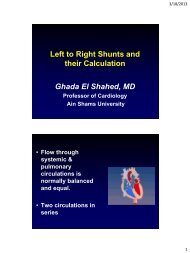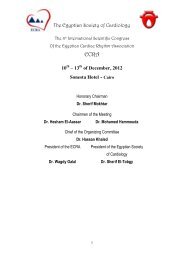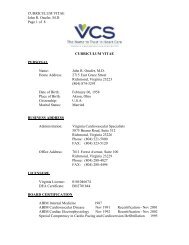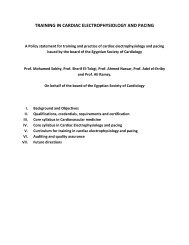the egyptian society of cardiology board of ... - Cardioegypt.com
the egyptian society of cardiology board of ... - Cardioegypt.com
the egyptian society of cardiology board of ... - Cardioegypt.com
Create successful ePaper yourself
Turn your PDF publications into a flip-book with our unique Google optimized e-Paper software.
Endo<strong>the</strong>lial Dysfunction & Insulin Resistance in Normoglycemic Offsprings<br />
2.5<br />
2<br />
1.5<br />
1<br />
0.5<br />
0<br />
HOMA-IR<br />
HOMA-IR<br />
p=0.013<br />
Control NOPD<br />
Figure 3: HOMA-IR in NOPD and Controls.<br />
Discussion<br />
The present study showed that: (a) normotensive<br />
normoglycemic <strong>of</strong>fsprings <strong>of</strong> type 2 diabetic subjects<br />
present insulin resistance and early endo<strong>the</strong>lial<br />
dysfunction, as <strong>the</strong>y had impaired FMD, while <strong>the</strong><br />
direct vasodilator capacity induced by GTN was<br />
not impaired. (b) FMD was impaired more in<br />
<strong>of</strong>fsprings <strong>of</strong> diabetics with more insulin resistance.<br />
Our findings are in agreement with Caballero<br />
et al [16] who showed decreased FMD and decreased<br />
microvascular reactivity in first degree<br />
relatives <strong>of</strong> type 2 diabetic subjects as <strong>com</strong>pared<br />
to controls.<br />
Balletsh<strong>of</strong>er et al [17] found impaired FMD in<br />
normoglycemic <strong>of</strong>fspring <strong>of</strong> diabetic parents, but<br />
this was significant only in insulin resistant normoglycemic<br />
<strong>of</strong>fspring <strong>of</strong> diabetic parents <strong>com</strong>pared<br />
to controls. There was no significant difference in<br />
GTN-MD between all <strong>the</strong> studied groups. Of note,<br />
that study included only 10 control subjects to<br />
<strong>com</strong>pare with 53 subjects with diabetic parents<br />
and smokers were not excluded from study. This<br />
may attenuate <strong>the</strong> difference between <strong>of</strong>fspring <strong>of</strong><br />
diabetic parents and controls as regard FMD.<br />
Fur<strong>the</strong>rmore, Chen et al [18], McSorley et al<br />
[19] and Iellamo et al [20] found a significantly<br />
reduced forearm vasodilation, indicating endo<strong>the</strong>lial<br />
dysfunction in normoglycemic first degree relatives<br />
<strong>of</strong> type 2 diabetic subjects. However, McSorley et<br />
al [19] did not find significant difference in HOMA-<br />
IR, an index <strong>of</strong> insulin resistance, between NOPD<br />
and controls, none<strong>the</strong>less, several findings from<br />
that study suggested <strong>the</strong> presence <strong>of</strong> hyperinsulinemic<br />
state in <strong>the</strong> NOPD group. These include higher<br />
22<br />
values <strong>of</strong> HbA1c and higher values for blood glucose<br />
120 minutes after OGTT con<strong>com</strong>itant with<br />
higher insulin levels, reflecting a relative hyperinsulinemic<br />
state. In addition, <strong>the</strong> area under glucose<br />
curve (AUCs) for glucose and insulin during OGTT<br />
were inversely correlated with FMD.<br />
Goldfine et al [21] found that FMD was reduced<br />
in normoglycemic <strong>of</strong>fsprings <strong>of</strong> type 2 diabetic<br />
subjects (even <strong>the</strong> most insulin-sensitive), with no<br />
difference in GTN-MD. This significant attenuation<br />
<strong>of</strong> endo<strong>the</strong>lial dysfunction even in insulin sensitive<br />
<strong>of</strong>fsprings could be due to enriched familiar difference<br />
in that study as both parents were diabetic.<br />
Moreover, <strong>the</strong> studied subjects had non significantly<br />
higher BMI <strong>com</strong>pared to our subjects (23.98±2.95<br />
Vs 22.89±2.71).<br />
Tesauro et al [22] found that normoglycemic<br />
<strong>of</strong>fsprings <strong>of</strong> type 2 diabetic subjects were more<br />
insulin resistant on average than <strong>the</strong> control group,<br />
and had significantly lower both FMD and GTN-<br />
MD <strong>com</strong>pared with <strong>the</strong> control group. They suggested<br />
that in addition to decreased insulin sensitivity;<br />
o<strong>the</strong>rwise healthy subjects with a family<br />
history <strong>of</strong> type 2 diabetes mellitus have impairment<br />
in vascular responsiveness to NO that may be<br />
endo<strong>the</strong>lium dependent and/or independent.<br />
In concordance <strong>of</strong> our results, Amudha et al<br />
[23] found that NOPD had significantly impaired<br />
FMD and higher HOMA-IR, reflecting endo<strong>the</strong>lial<br />
dysfunction and insulin resistance.<br />
Frequent presence <strong>of</strong> vascular pathology at <strong>the</strong><br />
time <strong>of</strong> diagnosis <strong>of</strong> diabetes suggests importance<br />
for identification <strong>of</strong> prediabetic persons with diminished<br />
endo<strong>the</strong>lial function and early a<strong>the</strong>rosclerotic<br />
disease and family history <strong>of</strong> diabetes is a<br />
recognized risk for development <strong>of</strong> diabetes [21].<br />
In normoglycemic <strong>of</strong>fspring <strong>of</strong> patients with<br />
type 2 diabetes mellitus, significant endo<strong>the</strong>lial<br />
dysfunction and insulin resistance are detectable<br />
even in <strong>the</strong> absence <strong>of</strong> frank diabetes. This suggests<br />
that genetic factors contributing to insulin resistance<br />
and diabetes may also influence development <strong>of</strong><br />
cardiovascular diseases including a<strong>the</strong>rosclerosis<br />
and coronary heart disease that are related to endo<strong>the</strong>lial<br />
dysfunction [22].<br />
From data <strong>of</strong> our study and o<strong>the</strong>r studies, we<br />
can speculate that NOPD present a blunted endo<strong>the</strong>lial<br />
function in relation to a primary inherited<br />
genetic susceptibility yet to be identified, or in<br />
relation to <strong>the</strong> metabolic alteration detectable even








